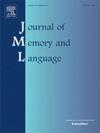对话中的协调指称:语言惯例与语言先例的选择
IF 3
1区 心理学
Q1 LINGUISTICS
引用次数: 0
摘要
说话者是如何将意思与他们的地址协调起来的,比如选择一个指称的表达方式,以最大限度地提高收件人识别其所指的可能性?语言为社区提供了一套惯例系统来解决反复出现的协调问题。此外,对涉及新颖和难以命名形状的重复参考的研究表明,最初的参考建立了一个先例,一个可以随后使用的特定于伴侣的视角。在涉及日常物品照片的参考交流任务中,本研究假设先例是在社区范围内关于如何提及实体的惯例不容易获得时由对话伙伴开发的临时解决方案。每个对象对约定的可达程度(即,对象名称的不确定性)是根据所有参与者第一次谈论该对象时使用的单词分布来量化的。两项研究的结果表明,对于名称不确定性较低的对象,一个二分体在连续两次提及时使用的表达并不比其他二分体使用的表达更相似,这表明对社区普遍惯例的依赖。然而,对于具有更大名称不确定性的物体,一个给定的二分体在连续两次被提及时产生的表情比它们与其他二分体的表情更相似。最后,随着对象名称的不确定性增加,第二次提及对象时使用裸名词短语(相对于确定或不定名词短语)的次数减少,这一发现进一步支持了对话伙伴依赖先例作为临时解决方案来补偿社区范围内惯例的不确定性的说法。本文章由计算机程序翻译,如有差异,请以英文原文为准。
Coordinating reference in conversation: The choice between linguistic conventions and linguistic precedents
How do speakers coordinate meaning with their addresses such as choosing a referring expression that maximizes the probability that their addressee identifies its referent? Language offers a community a system of conventions for recurrent coordination problems. Furthermore, research on repeated reference involving novel and hard-to-name shapes has claimed that an initial reference sets up a precedent, a partner-specific perspective that can be used subsequently. In a referential communication task involving photos of everyday objects, the present study hypothesized that precedents are temporary solutions developed by conversational partners when community-wide conventions on how to refer to the entity are not readily available. Degree of accessibility to conventions for each object (i.e., the object’s name uncertainty) was quantified based on the distribution of words used by all participants to talk about the object for the first time. Results from two studies showed that for objects with low name uncertainty, the expressions used by a dyad on two consecutives mentions were no more similar to each other than to expressions used by other dyads, suggesting reliance to community-wide conventions. For objects with greater name uncertainty, however, a given dyad’s expressions produced on two successive mentions resembled each other more than they resembled other dyads’ expressions. Finally, the usage of bare nominals (vs. definite or indefinite noun phrases) to refer to an object on second mention decreased as the object’s name uncertainty increased, a finding that further supports the claim that conversational partners rely on precedents as temporary solutions to compensate for uncertain availability of community-wide conventions.
求助全文
通过发布文献求助,成功后即可免费获取论文全文。
去求助
来源期刊
CiteScore
8.70
自引率
14.00%
发文量
49
审稿时长
12.7 weeks
期刊介绍:
Articles in the Journal of Memory and Language contribute to the formulation of scientific issues and theories in the areas of memory, language comprehension and production, and cognitive processes. Special emphasis is given to research articles that provide new theoretical insights based on a carefully laid empirical foundation. The journal generally favors articles that provide multiple experiments. In addition, significant theoretical papers without new experimental findings may be published.
The Journal of Memory and Language is a valuable tool for cognitive scientists, including psychologists, linguists, and others interested in memory and learning, language, reading, and speech.
Research Areas include:
• Topics that illuminate aspects of memory or language processing
• Linguistics
• Neuropsychology.

 求助内容:
求助内容: 应助结果提醒方式:
应助结果提醒方式:


